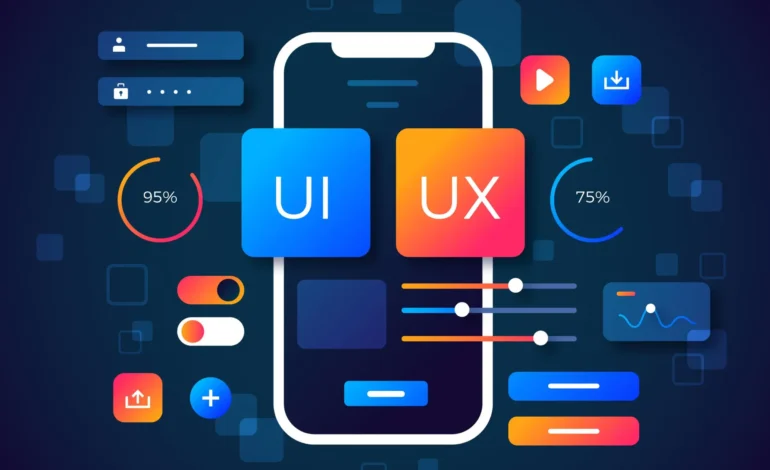
Why UX/UI Design Is Critical in Mobile App Development
When was the last time you downloaded a mobile app and uninstalled it within minutes? It probably didn’t take long to realise something felt off. Maybe the app was difficult to navigate, or perhaps it just didn’t look appealing. This is where UX (user experience) and UI (user interface) design come in. They’re not just about making apps look pretty; they’re about creating functionality and enjoyment that keeps users coming back.
What Exactly Is UX/UI Design?
To understand why UX/UI is so important, we need to break down what these terms actually mean.
UX Design
Focuses on the overall experience a user has when interacting with an app. Is it easy to use? Does it solve a problem efficiently? UX design is about understanding user needs and behaviours, then creating seamless journeys.
UI Design
Deals with the visual side of things. It’s about how the app looks: the layout, buttons, colours, fonts, and overall style. A well-designed UI ensures the app is visually engaging and intuitive.
While UX and UI are distinct, they work hand in hand. Good UX without strong UI can leave users frustrated, while great visuals with poor functionality won’t retain users for long.
First Impressions Count
Imagine opening a mobile app for the first time. What’s the first thing you notice? For most people, it’s the design. Users form an opinion within seconds, and if the design doesn’t grab their attention or looks outdated, they’re likely to abandon the app altogether.
UX/UI design sets the tone. It’s the first impression your app makes, and as we all know, first impressions matter. Experts offering app development services ensure your app has a sleek, professional look paired with easy navigation, as this immediately builds trust and encourages users to stick around.
Keeping Things Simple
Let’s face it: no one wants to waste time figuring out how an app works. The best apps are intuitive, guiding users naturally from one step to the next without confusion. This is where thoughtful UX/UI design shines.
For instance, think about how users log in or sign up. A well-designed app minimises the effort needed to complete these steps, offering options like social media login or biometric authentication. These small design choices can make a big difference in how users perceive the app and whether they’ll continue using it.
Enhancing Engagement and Retention
What makes people keep coming back to an app? Sure, content and functionality play a big role, but how the app feels to use is just as important. A strong UX/UI design keeps users engaged by offering a seamless, enjoyable experience.
Consider features like personalised recommendations, quick load times, and clear navigation. When users feel like an app gets them, they’re more likely to stick around. This is especially important when you’re competing with countless other apps in the same space.
Accessibility Matters
One aspect that often gets overlooked is accessibility. A truly great app is designed for everyone, including users with disabilities. This means considering things like screen reader compatibility, colour contrast, and font sizes.
UX/UI designers who prioritise accessibility not only create apps that are inclusive but also tap into a wider audience. Plus, it’s simply the right thing to do.
Standing Out in a Crowded Market
The mobile app market is massive. With millions of apps available, how do you make yours stand out? UX/UI design can give your app a competitive edge.
Imagine two apps with similar features. If one looks cluttered and confusing while the other is sleek and easy to navigate, which one would you choose? Thoughtful design isn’t just a bonus it’s often the deciding factor for users.
Additionally, apps that feel polished are more likely to earn positive reviews and recommendations, further boosting their visibility and success.
Boosting Conversions
Whether your app is focused on e-commerce, subscriptions, or ad revenue, a strong UX/UI design can directly impact your bottom line. A poorly designed app creates friction, making users less likely to complete purchases or engage with your monetisation strategy.
On the other hand, an app that feels effortless to use builds trust. Clear calls-to-action, straightforward checkout processes, and visually appealing layouts all contribute to higher conversion rates.
The Role of Feedback in UX/UI Design
One key element of effective UX/UI design is user feedback. The most successful apps are constantly evolving based on what users want.
Designers can gather insights from app reviews, usability testing, and analytics. This data helps identify pain points and opportunities for improvement, ensuring the app continues to meet user needs.
It’s a continuous process. What works today might not work tomorrow, so staying adaptable is essential.
Trends That Matter
While timeless design principles are crucial, it’s also important to stay on top of trends. Things like dark mode, micro-interactions, and voice interfaces are popular because they enhance usability and create modern, appealing apps.
However, trends should never be followed blindly. The focus should always remain on what serves the user best.
The Heartbeat of Mobile App Success
At its core, UX/UI design is about connection. It’s about understanding what users need and delivering it in a way that feels effortless and enjoyable. When done right, it transforms a functional app into something users genuinely love.
Investing in UX/UI design isn’t just a nice-to-have; it’s a must. It’s the difference between an app that gets uninstalled and one that becomes an integral part of someone’s daily routine.
Designing for the Future
As technology continues to evolve, so will user expectations. Apps of the future will need to adapt to emerging trends and new ways of interacting with devices. By prioritising UX/UI design now, developers can set the foundation for long-term success, staying ahead in an ever-competitive landscape.





